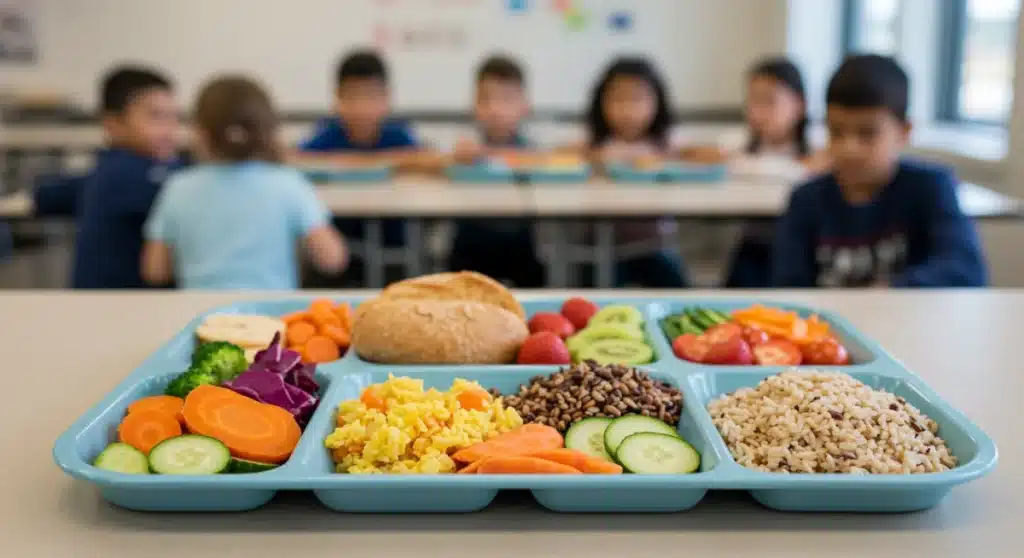NSLP Updates: Healthier Meals for Kids?

Recent developments in the National School Lunch Program (NSLP) are pushing for significant changes, aiming to provide healthier meals for kids across the nation. New proposals focus on reducing sugar and sodium, sparking both support and debate among stakeholders concerning feasibility and impact.
Breaking news indicates significant Updates on the National School Lunch Program: Healthier Meals for Kids? are currently under review, promising to reshape student nutrition nationwide. These proposed changes, announced by the U.S. Department of Agriculture (USDA), aim to enhance the nutritional quality of meals served to millions of children, sparking immediate discussion among parents, educators, and food service providers.
Understanding the New USDA Proposals
The U.S. Department of Agriculture (USDA) has unveiled new proposed standards for the National School Lunch Program (NSLP), signaling a major shift towards improving the healthfulness of meals served to students. These updates, announced on February 7, 2024, are designed to align school meals more closely with the latest dietary guidelines for Americans.
The core of these proposals focuses on key nutritional areas that have long been subjects of public health concern. The USDA emphasizes a commitment to fostering healthier eating habits from a young age, recognizing the critical role school meals play in children’s overall well-being and academic performance. This move reflects an ongoing effort to combat rising rates of diet-related diseases among youth.
Key Nutritional Targets
The new guidelines specifically target several components of school meals, aiming for incremental changes over the coming years. These adjustments are intended to be gradual, allowing schools and food manufacturers time to adapt to the new requirements without immediate drastic overhauls.
- Sodium Reduction: The proposals seek to reduce sodium levels in school meals by 30% over the next several years, with an initial 10% reduction by fall 2025.
- Sugar Limits: For the first time, added sugars would be capped in certain breakfast items, such as cereals, yogurts, and flavored milk, by fall 2025.
- Whole Grains Emphasis: Continued emphasis on whole grains remains a priority, building on previous efforts to increase fiber intake among students.
- Milk Options: Flavored milk would still be allowed, but with tighter sugar restrictions, ensuring children have appealing, healthier options.
The Rationale Behind Healthier School Meals
The driving force behind these significant revisions to the National School Lunch Program is a growing body of scientific evidence and public health concerns. Experts widely acknowledge that the eating habits established during childhood often persist into adulthood, directly impacting long-term health outcomes. The USDA’s initiative is a direct response to these findings, aiming to create a healthier food environment for students.
Moreover, the USDA cites the prevalence of diet-related diseases, such as childhood obesity, type 2 diabetes, and heart disease, as a critical motivator. By providing more nutritious meals, schools can play a pivotal role in preventing these conditions and promoting healthier lifestyles. This proactive approach is seen as an investment in the future health of the nation’s youth.
Addressing Public Health Concerns
For years, public health advocates have called for stricter nutritional standards in school meals. The current proposals address many of these long-standing concerns, particularly regarding excessive sugar and sodium intake, which are major contributors to poor health.
The USDA’s framework also considers the socioeconomic disparities in access to nutritious food. For many children from low-income families, school meals represent a significant portion of their daily caloric and nutritional intake. Ensuring these meals are as healthy as possible can help bridge nutritional gaps and promote equity in health outcomes.
Implementation Challenges and School Preparedness
While the goal of providing healthier meals is widely supported, the practical implementation of these new USDA standards for the National School Lunch Program presents several challenges for school districts nationwide. Food service directors and school administrators are now evaluating how these changes will impact their operations, budgets, and menus.
One primary concern revolves around the cost of sourcing healthier ingredients. Fresh produce, lean proteins, and low-sodium options can often be more expensive than their less nutritious counterparts. Schools, many already operating on tight budgets, will need adequate funding and resources to meet the new requirements without compromising the quality or quantity of meals served.
Another significant hurdle is student acceptance. Children can be particular about their food, and introducing new, healthier options may require creative strategies to ensure high participation rates. Schools are already exploring innovative ways to make nutritious foods appealing.

Navigating Operational Hurdles
Operational adjustments will also be necessary, from menu planning and recipe development to staff training and equipment upgrades. School food service staff play a crucial role in the success of these programs and will need support and training to adapt to new cooking methods and ingredient specifications.
- Supply Chain Adaptations: Schools will need to work closely with suppliers to ensure a consistent availability of compliant ingredients.
- Staff Training: Cafeteria workers will require training on new recipes, portion control, and food preparation techniques to meet the standards.
- Student Engagement: Educational initiatives and taste tests can help students embrace the healthier choices, reducing food waste.
Stakeholder Reactions and Public Commentary
The announcement of the proposed changes to the National School Lunch Program has generated a wide range of reactions from various stakeholders across the country. The USDA has opened a public comment period, inviting feedback from individuals and organizations, which is a critical step in the policymaking process.
Advocacy groups focused on child health and nutrition have largely applauded the USDA’s efforts, viewing the proposals as a necessary step forward in addressing the childhood obesity crisis and improving overall student well-being. They emphasize the long-term benefits of instilling healthy eating habits early in life.
However, some school food service directors and industry representatives have expressed concerns about the feasibility and potential financial burden of the new regulations. They highlight challenges such as increased food costs, potential for food waste if students reject new menu items, and the need for significant operational adjustments.
Diverse Perspectives
Parents also hold varied opinions, with some strongly supporting the push for healthier options and others worried about the practicality of implementation and potential impact on meal participation. The USDA is carefully considering all feedback received during the public comment period, which is set to close in April 2024, before finalizing the rules.
This public engagement period is crucial for ensuring that the final regulations are both effective in promoting health and pragmatic for schools to implement. The USDA aims for a balanced approach that addresses nutritional needs while acknowledging the operational realities of school food service.
The Impact on Food Manufacturers and Suppliers
The proposed Healthier School Meals standards under the National School Lunch Program will inevitably have a significant ripple effect on food manufacturers and suppliers. These companies, which provide a vast array of products to school districts, will need to adapt their offerings to meet the new nutritional requirements, particularly regarding sodium and added sugar content.
Manufacturers are already beginning to assess their product lines, identifying items that will need reformulation to comply with the stricter guidelines. This could involve investing in research and development to create new recipes or modifying existing ones to reduce undesirable ingredients while maintaining taste and appeal for students. The shift could also stimulate innovation within the food industry, leading to a wider availability of healthier processed foods.
Suppliers, in turn, will need to adjust their inventory and distribution networks to cater to schools demanding more compliant products. This could mean forging new relationships with producers of healthier ingredients or expanding their current offerings to include more whole grains, fresh produce, and low-sodium items. The changes could also favor smaller, local producers capable of supplying fresh, minimally processed foods.
Anticipated Industry Shifts
The demand for healthier school meal components is expected to drive market changes. This includes a potential increase in the production of low-sugar dairy products, whole-grain bread and pasta, and lower-sodium processed foods. Companies that can quickly adapt and innovate will likely gain a competitive advantage in the school food market.
Long-Term Vision for Student Nutrition
The USDA’s proposed Updates on the National School Lunch Program: Healthier Meals for Kids? are part of a broader, long-term vision to improve student nutrition and public health in the United States. These efforts extend beyond simply reducing unhealthy components; they aim to foster a culture of health and well-being within school communities.
The ultimate goal is to ensure that all children have access to nutritious meals that support their physical and cognitive development, regardless of their socioeconomic background. By setting higher standards for school meals, the USDA is working to establish a foundation for lifelong healthy eating habits, contributing to a healthier future generation.
Beyond the Cafeteria
This long-term vision also recognizes that school meals are just one piece of the puzzle. Comprehensive approaches to student nutrition often involve:
- Nutrition Education: Integrating lessons on healthy eating into the curriculum to empower students with knowledge.
- Physical Activity: Promoting regular physical activity alongside healthy eating for holistic well-being.
- Community Engagement: Collaborating with families and local communities to support healthy choices outside of school hours.
- Wellness Policies: Encouraging schools to develop and implement robust wellness policies that address all aspects of student health.
These combined efforts are crucial for creating an environment where healthy choices are the easy choices, helping children thrive academically and personally.
| Key Point | Brief Description |
|---|---|
| USDA Proposals | New standards target significant reductions in sodium and added sugars in school meals. |
| Health Rationale | Aims to combat childhood obesity and diet-related diseases by promoting healthier eating habits. |
| Implementation Challenges | Concerns include increased costs, student acceptance, and operational adjustments for schools. |
| Industry Impact | Food manufacturers and suppliers must reformulate products to meet new nutritional guidelines. |
Frequently Asked Questions About Healthier School Meals
The proposed changes primarily focus on reducing sodium levels by 30% and setting the first-ever limits on added sugars in certain breakfast items and flavored milk. These adjustments aim to align school meals with current dietary guidelines for better child health outcomes.
The USDA plans for a phased implementation. Initial sodium reductions and added sugar limits are anticipated to begin by fall 2025. Further reductions in sodium will be phased in over subsequent years, allowing schools and food producers time to adapt gradually.
Schools anticipate potential increases in food costs due to sourcing healthier ingredients. Operational adjustments will also be necessary, including menu redesign, staff training for new recipes, and potential equipment upgrades to meet the stricter nutritional guidelines effectively.
Student acceptance is a key concern. Schools plan to use strategies like taste testing, nutrition education, and creative menu planning to make healthier foods appealing. The goal is to ensure high participation rates while improving the nutritional quality of meals served.
The USDA has opened a public comment period for these proposed rules, inviting feedback from all stakeholders. This period is crucial for gathering diverse perspectives before the final regulations are issued, ensuring a comprehensive and balanced approach to school nutrition.
What Happens Next
As the public comment period for the proposed National School Lunch Program updates draws to a close in April 2024, the USDA will meticulously review all submitted feedback. This crucial phase will inform the finalization of the rules, which are expected to be issued later this year. Schools and food manufacturers will then embark on the challenging yet vital process of preparing for the phased implementation, beginning in fall 2025. The success of these initiatives hinges on continuous collaboration among federal agencies, state departments of education, school districts, and the food industry, all working towards a common goal: ensuring healthier meals for every child.





